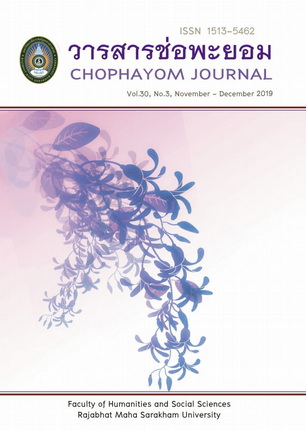Results-Based Performance Management for Personnel in Champasak Province, Lao People’s Democratic Republic
Keywords:
Results-Based Performance Management, Personnel, Lao People’s Democratic RepublicAbstract
The purposes of the research were 1) to investigate the current results-based performance management for personnel in Champasak province, Lao People’s Democratic Republic; 2) to design a model of results-based performance management for the personnel; and 3) to implement and evaluate the model of results-based performance management. The research was divided into three phases. In the first phase, the current results-based performance management for personnel in Champasak province, Lao People’s Democratic Republic was investigated. The samples were three hundred and eighty nine participants consisting of the executive staff, and officers under the Champasak provincial office. Yamane’s calculation (1967), and proportional stratified random sampling and simple random sampling were used to manipulate the sample size and sampling. A questionnaire with reliability value at 0.86 was employed to collect data, then were analyzed by percentage, mean, and standard deviation. In the second phase, a model of result-based performance management was designed by phase 1 variables at an average below 3.51. The model was criticized by a focus group technique and commented by experts. In the third phase, the model was implemented with thirty eight members of the executive staff of Pakse district by a simple random sampling. The instrument included the model of results-based performance management, and an evaluation form of the result-based performance management. Data were compared between before and after an implementing by MANOVA. The findings of the research founded that: 1) the current results-based performance management of the personnel in Champasak province, Lao People’s Democratic Republic as a whole and in each aspect of a performance evaluation, an evaluation planning, a performance improvement, and a performance development, were at a moderate level. The personnel with different genders, ages, educational levels, and work experiences regarding the current results-based performance management in Champasak province were significantly different at the .05 level. 2) The model of the results-based performance management for the personnel in Champasak province was development activities including a performance evaluation, a collaborative evaluation planning, a personnel development learning, duties and responsibilities, and a role play. 3) The personnel in Champasak provincial office had work performance before and after implementing the model was significantly different at the .05 level. It revealed that the model was efficient and practical for the results-based performance management. Keywords : Results-Based Performance Management, Personnel, Lao People’s
Democratic Republic
References
2.Niorn Srisoontorn. (2016). The Development of a Performance Management Model of the Primary Educational Service Area Office. Dissertation of Doctor of Philosophy in Education Management, Education Faculty, Burapha University.
3.Office of the Civil Authority Commission. (n.d.) System of Authocratic Administration of Lao People’s Democratic Republic. Bangkok: Kornkanok Printing.
4.Osborne,D. and Gaebler, T. (1990). Reinventing Government. Addison-Wesley Publ.Co.
5.Sirinat Onbumrong, Aritaya Tanyapeuch, Nisa Nuntadee, & Keson Pomme. (2011). “The Study of Knowledge, Under standing about Result-Based Assessment of Personnel in Faculty of Siriraj Medical Nurse.” Siriraj Medical Journal. 57(8).
6.Smit Satchanukorn. (2010). Welcoming and Excellent Service. 6thed. Bangkok:Saitarn.
7.Siwakorn Ratichot. (2012). The Conditions and Problems of Results-Based Management for the Achiement of Basic Education School Personnel. Online-Jounal of Education (OJED), Vol.7, No.1, 2012, pp. 2309-2323 Chulalpngkorn University.
8.Somyot Yamphuen. (2008). Factors Affecting Performance Efficiency of the personnel of Asia Marine Company Lomited (Public). Thesis for Master’s Degree in Management, Graduate School of Srinakharinratawirot University.
9.Takornsak Prommasaka Na Sakonnakorn. (2013). Factors Affecting thePerformanace of Royal Thai Army Radio and Television. An Independent Study of Master of Sciences in Human Resources Management, Sripratum.
10.Wilawan Rapeepisarn. (2011). Basic Knoeledge of Human Resource Administration. Bangkok: Wichithathakorn Press.
11.Yamane, T. (1967). Statistics : An Introductory Analysis. New York : Harper and Row.






